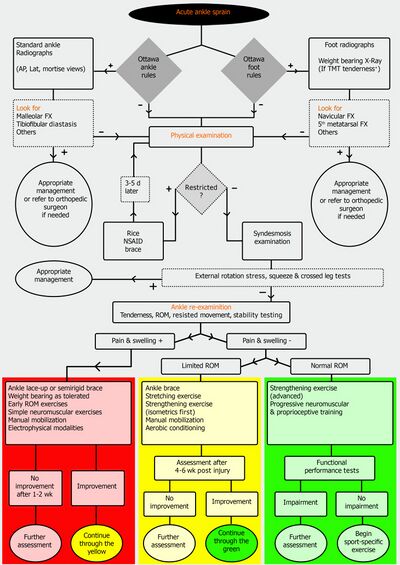Management of Ankle Sprains: Difference between revisions
No edit summary |
No edit summary |
||
| Line 14: | Line 14: | ||
=== Medial Ankle Sprain === | === Medial Ankle Sprain === | ||
On the [[Ankle Sprain|medial side]] the strong, deltoid ligament complex [posterior tibiotalar (PTTL), tibiocalcaneal (TCL), tibionavicular (TNL) and anterior tibiotalar ligaments (ATTL)] is injured with forceful "pronation and rotation movements of the hindfoot". <ref>Beynnon BD, Murphy DF, Alosa DM. Predictive Factors for Lateral Ankle Sprains: A Literature Review. J Athl Train. 2002 Dec;37(4):376-380. </ref> | On the [[Ankle Sprain|medial side]] the strong, deltoid ligament complex [posterior tibiotalar (PTTL), tibiocalcaneal (TCL), tibionavicular (TNL) and anterior tibiotalar ligaments (ATTL)] is injured with forceful "pronation and rotation movements of the hindfoot". <ref name=":1">Beynnon BD, Murphy DF, Alosa DM. [https://www.researchgate.net/publication/10598147_Predictive_Factors_for_Lateral_Ankle_Sprains_A_Literature_Review Predictive Factors for Lateral Ankle Sprains: A Literature Review]. J Athl Train. 2002 Dec;37(4):376-380. </ref> | ||
=== Syndesmotic Ankle Sprain === | === Syndesmotic Ankle Sprain === | ||
| Line 24: | Line 24: | ||
Predisposing factors are the risk factors for the ankle sprains. <ref name=":2" /> Identifying risk factors helps the clinician to choose the most appropriate treatment regimen given the fact that those risk factors have a significant impact on the patient's recovery.<ref name=":2" />They are divided into two categories:intrinsic and extrinsic. | Predisposing factors are the risk factors for the ankle sprains. <ref name=":2" /> Identifying risk factors helps the clinician to choose the most appropriate treatment regimen given the fact that those risk factors have a significant impact on the patient's recovery.<ref name=":2" />They are divided into two categories:intrinsic and extrinsic. | ||
Intrinsic risk factors for outcome prediction include: | Intrinsic risk factors for outcome prediction include:<ref name=":1" /> | ||
* age | * age and gender | ||
* height and weight | |||
* activity level | * activity level | ||
* grade of injury | * grade of injury | ||
* functional status | * functional status | ||
* associated injury | * associated injury, especially previous sprain | ||
* limb type: dominance, anatomic foot type and foot size, joint laxity, anatomic alignment, range of motion of the ankle-foot complex | |||
* muscle strength | |||
* posture, particularly postural sway | |||
Revision as of 17:36, 24 January 2022
Introduction[edit | edit source]
Ankle sprains are considered one of the most frequent traumatic type of injuries. Yeung et al, 1994, in an epidemiological study of unilateral ankle sprains, reported that the dominant leg is 2.4 times more vulnerable to sprain than the non-dominant one.[1]There were reports proposing that the greater the level of plantar flexion the higher the likelihood of sprain. [2]A conservative treatment is the common approach to ankle injury. The prognosis is generally good, but there is a number of factors influencing the full recovery.[3]These factors, when early identified, can change the treatment protocol to more aggressive approach.[3]
Clinically Relevant Anatomy[edit | edit source]
Lateral Ankle Sprain[edit | edit source]
The literature suggests that 85% of the ankle sprains involves lateral ligaments. [4]The anterior talofibular ligament (ATFL) of the lateral ankle ligament complex is the most frequently damaged when lateral ankle sprain occurs. Their anatomical location and the mechanism of sprain injury mean that the calcaneo-fibular (CFL) and posterior talofibular ligaments (PTFL) are less likely to sustain damaging loads.
Medial Ankle Sprain[edit | edit source]
On the medial side the strong, deltoid ligament complex [posterior tibiotalar (PTTL), tibiocalcaneal (TCL), tibionavicular (TNL) and anterior tibiotalar ligaments (ATTL)] is injured with forceful "pronation and rotation movements of the hindfoot". [5]
Syndesmotic Ankle Sprain[edit | edit source]
The stabilising ligaments of the distal tibio-fibular syndesmosis are the anterior-inferior, posterior-inferior, and transverse tibio-fibular ligaments, the interosseous membrane and ligament, and the inferior transverse ligament. A syndesmotic ankle sprain occurs with combined external rotation of the leg and dorsiflexion of the ankle.
Mechanism of Injury[edit | edit source]
Predisposing Factors[edit | edit source]
Predisposing factors are the risk factors for the ankle sprains. [3] Identifying risk factors helps the clinician to choose the most appropriate treatment regimen given the fact that those risk factors have a significant impact on the patient's recovery.[3]They are divided into two categories:intrinsic and extrinsic.
Intrinsic risk factors for outcome prediction include:[5]
- age and gender
- height and weight
- activity level
- grade of injury
- functional status
- associated injury, especially previous sprain
- limb type: dominance, anatomic foot type and foot size, joint laxity, anatomic alignment, range of motion of the ankle-foot complex
- muscle strength
- posture, particularly postural sway
Classification Grading Systems[edit | edit source]
Clinical Presentation[edit | edit source]
add text here relating to the clinical presentation of the condition
Diagnostic Procedures[edit | edit source]
add text here relating to diagnostic tests for the condition
Outcome Measures[edit | edit source]
add links to outcome measures here (see Outcome Measures Database)
Management[edit | edit source]
Acute Phase[edit | edit source]
Subacute Phase[edit | edit source]
Chronic Phase[edit | edit source]
add text here relating to management approaches to the condition
Resources
[edit | edit source]
add appropriate resources here
References[edit | edit source]
- ↑ Yeung MS, Chan KM, So CH, Yuan WY. An epidemiological survey on ankle sprain. Br J Sports Med. 1994 Jun;28(2):112-6.
- ↑ Wright IC, Neptune RR, van den Bogert AJ, Nigg BM. The influence of foot positioning on ankle sprains. J Biomech. 2000 May;33(5):513-9.
- ↑ 3.0 3.1 3.2 3.3 Ferreira JN, Vide J, Mendes D, Protásio J, Viegas R, Sousa MR. Prognostic factors in ankle sprains: a review. EFORT Open Rev. 2020 Jun 1;5(6):334-338.
- ↑ Halabchi F, Hassabi M. Acute ankle sprain in athletes: Clinical aspects and algorithmic approach. World J Orthop. 2020 Dec 18;11(12):534-558.
- ↑ 5.0 5.1 Beynnon BD, Murphy DF, Alosa DM. Predictive Factors for Lateral Ankle Sprains: A Literature Review. J Athl Train. 2002 Dec;37(4):376-380.







